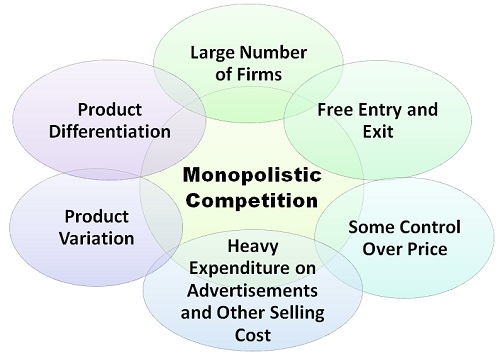Meaning and Characteristics of Monopolistic Competition
Here, we understand the term Monopolistic Competition and its Characteristics in detailed.

Do you have similar website/ Product?
Show in this page just for only
$2 (for a month)

0/60
0/180
Monopolistic Competition:
This concept has been introduced by the American economist Prof. E.H.Chamberlin in his book, "The Theory of Monopolistic Competition."
According to Prof. Chamberlin, there prevails neither pure competition nor pure monopoly but a blending of both competition and monopoly which he calls 'Monopolistic Competition.'
Now, we will discuss the Characteristics of Monopolistics Competition one by one in detailed-
Characteristics of Monopolistic Competition:
The following are the main characteristics of monopolistic competition:

- Existence of Many Firms: This is also one of the main characteristics of Monopolist Competition. There are many firms working in the industry, each of them producing differentiated products which are close substitutes for each other. In other words, under monopolistic competition there is a large number of firms. An individual firm has relatively small part of the total market, that each has a very limited control over the price of the product. Each firm determines its price-output policies independently without considering the possible reactions of the rival firms. No firm's action influence the others in any significant way. Each firm controls only a small part of the total output, therefore, any action on its part to increase or decrease the output and price will have little or no effect on the rival firms.
- Product differentiation: This is also most important feature of Monopolistic Competition. Here, every firm makes product that is different in one way or other from other products. Product differentiation is the soul of monopolistic competition. All firms are producing goods that are close substitutes of one another but dissimilar in shape, colour, smell, design, packing, etc. This distinction gives every firm some monopoly power to set and raise price within limits, without much fear of losing consumers that like and love the product. Product differentiation is also done through services. For eg- welcoming consumers with a smile, winning manners, credit facilities, repair and replacement warranties etc.
- Ease of Entry and Exist: This also important feature of Monopolistic Competition, that is there is no difficulty for a new firm to enter the industry or for the existing firms to leave the industry.
- Existence of Selling Costs: This also important feature of Monopolistic Competition. Under monopolistic competition there is a fairly large number of firms each one producing differentiated products which are relatively close substitutes for each other. It becomes necessary for the firms to incur selling costs. Selling costs have been defined as costs incurred in order to alter the position or shape of the demand curve for a product. These are costs which are incurred by a firm to persuade customers to buy its product in preference to those of others. Selling costs include all media of advertisement and publicity like radio, television, slides, newspapers, posters, gift coupons etc.
- Control over Price: This is also important feature of Monopolistic Competition. Because of product differentiation, each firm has partially independent market and therefore, it has some control over the price. In other words, the buyers come to regard the product of one firm as distinct from the products of other firms, a rise in the price will not make one firm lose all its sales to other firms. It is only when price differences are very large that the customers of one firm may be attracted towards other firms by the prospects of lower prices. Likewise, if a firm lowers its price, it cannot expect to boost up its sales substantially by attracting the customers of the rival firms because of product differentiation, unless there is a considerable reduction in price. An individual firm under monopolistic competition has some sort of monopoly of its product, it enjoys some sort of monopoly power, can control the price, but at the same time, it also subject to the competition of more or less imperfect substitutes of the rival firms.
- Different Prices for Differentiated Products: This is also important feature of Monopolistic Competition. Here, each firm produces a differentiated product. Through repeated advertisement, publicity and other devices each firm tries to create an impression upon the minds of the consumers that its product is superior to that of its rival firms. Means, each firm tries to differentiate its product from that of the other product in regard to quality, design, colour, etc. These differences may be real or imaginary but the fact remains that the consumers come to regard the product of one firm as superior to that of other firms. we find different prices for different brands of soap, toothpaste, electric fans etc. Extent of price differential will, is the main, depend upon the degree of product differentiation. If the consumer think that there is a high degree of product differentiation, differences in the prices of the products will be large and if there is low degree of product differentiation, price differences will be small.
CONTINUE READING
Meaning of Monopolistic Competition
Characteristics- Existence of Many Firms
Product differentiation
Ease of Entry and Exist
Existence of Selling Costs
Control over Price
Different Prices for Differentiated Products
Monopolistic Competition - Meaning and Characteristics of Monopolistic Competition.
Kinnari
Tech writer at NewsandStory
